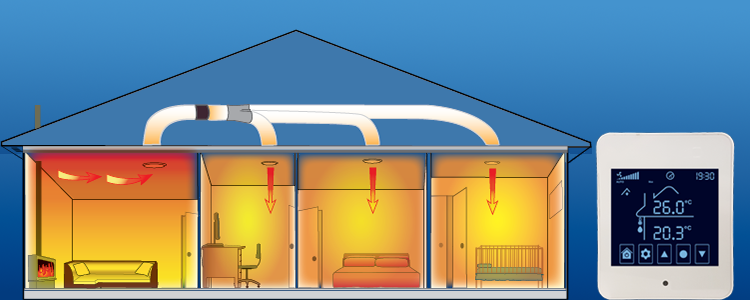How To Optimize Thermal Conductivity with DVS Heat Transfer Systems in Extreme Environments
Wiki Article
Exploring the Benefits and Applications of Heat Transfer Equipments in Modern Sector
Heat transfer systems play a vital function in modern market. They include numerous devices such as convection, conduction, and radiation, each adding to reliable thermal monitoring. Industries like production and aerospace benefit considerably from these systems. As improvements continue, the integration of innovative products and innovations promises to boost power efficiency. This advancement elevates crucial questions concerning the future effects for sustainability and operational costs across numerous industries. What exists in advance in this ongoing makeover?Understanding Heat Transfer Concepts
Heat transfer concepts are fundamental to the operation of various commercial systems. These concepts incorporate the systems of convection, radiation, and conduction, each playing a crucial duty in handling thermal power. Comprehending transmission involves assessing how Heat relocates with solid products, while convection pertains to Heat transfer in liquids, driven by liquid motion. Radiation, distinct from the other 2, includes power transfer through electromagnetic waves. The performance of Heat transfer effects system efficiency, energy usage, and total productivity. Efficient thermal monitoring is important in procedures such as Heat, home heating, and air conditioning healing. By understanding these principles, markets can maximize their procedures, reduce energy expenses, and enhance tools durability, therefore adding to a more efficient and sustainable industrial landscape.Secret Sorts Of Heat Transfer Systems
While various industries utilize Heat transfer systems for diverse applications, a number of key types attract attention because of their certain features and efficiencies. The most common types include convection, radiation, and transmission systems. Conduction systems transfer Heat via straight get in touch with between products, making them effective in solid-state applications. Convection systems, on the other hand, utilize fluid activity to move Heat, appropriate for home heating or cooling down gases and fluids. Radiation systems run without a medium, depending on electromagnetic waves to transfer Heat, perfect for high-temperature settings. Each type serves distinct objectives, permitting markets to tailor their Heat transfer remedies based upon operational needs, power performance, and cost-effectiveness. Comprehending these systems is important for maximizing efficiency in numerous industrial setups.Industrial Applications of Heat Transfer Technologies
The application of Heat transfer technologies in industry plays a crucial role in boosting power effectiveness and enhancing procedures. DVS Heat Transfer Systems. By implementing advanced Heat exchange systems, firms can considerably lower their environmental impact while boosting general productivity. This combination not only promotes sustainability but additionally aligns with contemporary governing and consumer demands for greener techniquesEnergy Effectiveness Improvements
As industries significantly prioritize sustainability, energy performance enhancements in Heat transfer innovations have actually ended up being essential for minimizing operational prices and environmental effect. Improved Heat exchangers, as an example, make use of advanced materials and layouts to optimize thermal performance while reducing energy usage. Moreover, integrating variable rate drives in pumping systems enables much better control of liquid circulation, resulting in significant energy financial savings. The application of clever sensing units and automation provides real-time monitoring, allowing modifications that optimize energy use. Additionally, waste Heat healing systems capture excess thermal energy, transforming it right into functional power. These innovations not just boost power performance yet additionally add to a much more lasting commercial landscape by lowering greenhouse gas emissions and sustaining conformity with ecological laws.Refine Optimization Techniques
Refine optimization strategies are critical in enhancing the effectiveness and efficiency of Heat transfer innovations in industrial applications. These techniques involve refining procedures to optimize Heat transfer performance while lessening energy intake and operational expenses. Methods such as computational liquid characteristics (CFD) modeling permit engineers to imitate and examine Heat transfer scenarios, recognizing locations for renovation. Furthermore, real-time tracking systems can offer valuable information on temperature level gradients and circulation prices, enabling adjustments that maximize performance. Applying sophisticated control strategies, such as anticipating analytics, can enhance system responsiveness to differing operational look at here now demands. By applying these optimization strategies, markets can accomplish better thermal effectiveness, reduced downtime, and enhanced item top quality, eventually leading to boosted competitiveness in the market.
Ecological Effect Decrease
While industrial Heat transfer technologies are essential for functional performance, their application likewise offers opportunities for considerable environmental effect decrease. By improving energy effectiveness, these systems minimize fuel usage, resulting in reduced greenhouse gas emissions. Progressed Heat exchangers can recover waste Heat, redirecting it to preheat inbound liquids, thus minimizing power demands. In addition, the combination of Heat transfer innovations in sustainable power systems, such as solar thermal and geothermal applications, supports the change to sustainable techniques. Industries that use these technologies likewise gain from minimized functional expenses and improved governing conformity. On the whole, the strategic application of Heat transfer systems not just boosts performance yet additionally cultivates an extra lasting commercial landscape, adding to international ecological objectives.Benefits of Effective Heat Transfer Solutions
Effective Heat transfer systems provide considerable advantages in modern sector, largely via boosted power effectiveness and expense decrease. By maximizing thermal monitoring, these systems lessen energy waste, causing lower operational expenses (DVS Heat Transfer Systems). Organizations can accomplish higher sustainability and boosted productivity.
Energy Effectiveness Improvements
As markets significantly focus on sustainability and cost-effectiveness, power efficiency enhancements in Heat transfer systems have actually become a critical focus. Enhanced efficiency in these systems results in lowered energy usage, enabling facilities to operate more sustainably. By optimizing Heat transfer techniques, industries can decrease waste Heat and achieve better thermal look at this website administration, greatly lowering their environmental effect. Breakthroughs in innovations such as Heat exchangers and insulation materials contribute to boosted efficiency and dependability. In addition, carrying out energy-efficient Heat transfer options not just sustains compliance with governing criteria however likewise fosters a culture of development within companies. Eventually, these enhancements are essential in lining up industrial operations with worldwide energy conservation goals, leading the way for an extra lasting future in production and handling sectors.Price Decrease Opportunities
By maximizing Heat transfer systems, industries can expose significant cost reduction opportunities that improve their lower line. Effective Heat transfer decreases power usage, leading to lower utility costs and reducing functional expenses. Additionally, improved system performance lowers the demand for repair and maintenance, additionally conserving expenses gradually. Enhanced Heat transfer can additionally expand equipment lifespan, allowing firms to postpone capital investment on substitutes. Waste Heat recuperation systems can change excess Heat right into useful energy, further driving down costs. These systems not just improve processes yet additionally add to sustainability campaigns, positioning companies positively in an increasingly eco-conscious market. In general, the economic advantages of effective Heat transfer systems are considerable and necessary for affordable benefit.Developments in Heat Transfer Solutions
Just how can contemporary industry boost its procedures through cutting-edge Heat transfer options? By adopting innovative materials and modern technologies, markets can greatly enhance thermal performance and efficiency. Developments such as nanofluids, which enhance Heat transfer abilities past traditional liquids, and phase adjustment products that store and launch thermal energy, are gaining grip. Additionally, the integration of smart sensing units and IoT gadgets enables real-time monitoring and optimization of Heat transfer processes, minimizing waste and enhancing system responsiveness. Additive production methods enable the creation of even more complicated Heat exchangers that optimize surface location while minimizing product use. Jointly, these developments drive functional efficiency and produce affordable benefits in various fields, including production, aerospace, and energy.The Role of Heat Transfer in Sustainability Efforts
While the press for sustainability proceeds to improve sectors, the duty of Heat transfer technologies ends up being significantly necessary in attaining environmental objectives. Reliable Heat transfer systems help with energy performance by maximizing thermal management in various procedures, substantially decreasing power consumption and greenhouse gas discharges. i was reading this Progressed Heat exchangers are used in commercial applications to redeem waste Heat, consequently lessening energy waste. Furthermore, advancements such as phase modification products boost thermal storage, contributing to renewable resource assimilation. The adoption of sustainable fluids in Heat transfer systems can minimize ecological influence. By prioritizing effective Heat transfer, markets not just improve operational efficiency but also line up with worldwide sustainability efforts, fostering a cleaner, extra sustainable future.Frequently Asked Concerns
Exactly How Do Heat Transfer Systems Effect Energy Expenses in Manufacturing?
Heat transfer systems markedly influence energy prices in manufacturing by improving performance, reducing waste, and maximizing thermal administration. These enhancements cause reduce operational expenses, inevitably profiting general productivity and success in industrial procedures.What Maintenance Is Required for Heat Transfer Equipments?
Maintenance for Heat transfer systems includes routine evaluations, cleaning of components, checking liquid degrees and problems, replacing used components, and making sure appropriate insulation. These actions boost performance, prolong lifespan, and protect against expensive break downs in operation.Exist Security Interest In Heat Transfer Solutions?
Safety worries with Heat transfer systems include prospective leaks, stress build-up, and thermal dangers. Proper style, regular maintenance, and adherence to security protocols are important to minimize these dangers and assure secure procedure in commercial environments.
Just How Can I Pick the Right Heat Transfer System for My Service?
Choosing the ideal Heat transfer system entails reviewing elements such as performance, application needs, spending plan constraints, and security requirements. An extensive analysis of these components will certainly help ensure perfect efficiency and dependability in organization procedures.What Prevail Failures in Heat Transfer Solutions and Their Causes?

Comprehending conduction entails analyzing exactly how Heat moves with strong products, while convection pertains to Heat transfer in liquids, driven by liquid motion. By enhancing Heat transfer methods, markets can reduce waste Heat and attain better thermal administration, substantially reducing their ecological influence. Waste Heat recovery systems can transform excess Heat right into useful power, further driving down expenses. Advanced Heat exchangers are utilized in industrial applications to redeem waste Heat, therefore minimizing energy waste. Typical failures in Heat transfer systems include leaks, rust, and ineffective Heat exchange.
Report this wiki page